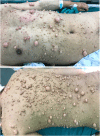Detection of severe hypertension in a patient with neurofibromatosis type 1 during anesthesia induction: a case report
- PMID: 31783902
- PMCID: PMC6884750
- DOI: 10.1186/s13256-019-2292-4
Detection of severe hypertension in a patient with neurofibromatosis type 1 during anesthesia induction: a case report
Abstract
Background: Neurofibromatosis type 1 has a higher prevalence of pheochromocytoma and paraganglioma than the general population: 1.0-5.7% versus 0.2-0.6%. Currently, there are no generally accepted guidelines for screening for pheochromocytoma and paragangliomas in asymptomatic patients with neurofibromatosis type 1.
Case presentation: Severe hypertension developed during anesthesia induction in our patient, a 44-year-old Chinese man with neurofibromatosis type 1. We screened for catecholamine level after glioma resection, and the patient was diagnosed with combined pheochromocytoma and paraganglioma.
Conclusions: A delay in diagnosis or lack of a diagnosis in pheochromocytoma and paraganglioma may increase the perioperative morbidity and mortality risk due to excess catecholamine secretion. Therefore, routine pheochromocytoma and paraganglioma screening preoperatively in patients with neurofibromatosis type 1 is very important.
Keywords: Catecholamine; Neurofibromatosis type 1; Pheochromocytoma and paraganglioma; Screening.
Conflict of interest statement
The authors declare that they have no competing interests.
Figures
Similar articles
-
Perioperative outcomes of syndromic paraganglioma and pheochromocytoma resection in patients with von Hippel-Lindau disease, multiple endocrine neoplasia type 2, or neurofibromatosis type 1.Surgery. 2017 Dec;162(6):1259-1269. doi: 10.1016/j.surg.2017.08.002. Epub 2017 Sep 14. Surgery. 2017. PMID: 28919049
-
The importance of pheochromocytoma case detection in patients with neurofibromatosis type 1: A case report and review of literature.SAGE Open Med Case Rep. 2017 Nov 16;5:2050313X17741016. doi: 10.1177/2050313X17741016. eCollection 2017. SAGE Open Med Case Rep. 2017. PMID: 29201372 Free PMC article.
-
Pheochromocytoma/Paraganglioma: Review of perioperative management of blood pressure and update on genetic mutations associated with pheochromocytoma.J Clin Hypertens (Greenwich). 2013 Jun;15(6):428-34. doi: 10.1111/jch.12084. Epub 2013 Mar 15. J Clin Hypertens (Greenwich). 2013. PMID: 23730992 Free PMC article. Review.
-
[Pheochromocytoma associated with primary hyperparathyroidism and type 1 neurofibromatosis].Khirurgiia (Mosk). 2023;(7):120-127. doi: 10.17116/hirurgia2023071120. Khirurgiia (Mosk). 2023. PMID: 37379415 Russian.
-
Pheochromocytomas and Paragangliomas.Endocrinol Metab Clin North Am. 2019 Dec;48(4):727-750. doi: 10.1016/j.ecl.2019.08.006. Endocrinol Metab Clin North Am. 2019. PMID: 31655773 Review.
Cited by
-
Neurofibromatosis Type 1: Optimizing Management with a Multidisciplinary Approach.J Multidiscip Healthc. 2024 Apr 23;17:1803-1817. doi: 10.2147/JMDH.S362791. eCollection 2024. J Multidiscip Healthc. 2024. PMID: 38680880 Free PMC article. Review.
-
Orthopaedic manifestations of neurofibromatosis type 1: A case report.Exp Ther Med. 2022 Feb;23(2):135. doi: 10.3892/etm.2021.11058. Epub 2021 Dec 13. Exp Ther Med. 2022. PMID: 35069816 Free PMC article.
References
Publication types
MeSH terms
LinkOut - more resources
Full Text Sources
Medical
Research Materials



